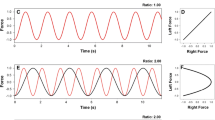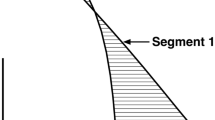Abstract
The present studies examined the nature of kinematic interlimb interference during bilateral elbow movements of 1:1, 2:1 and 3:1 frequency ratios and the manner in which subjects cope with coordination bias. Analysis of movement trajectories in the first experiment indicated progressively greater angular velocity assimilation across 2:1 and 3:1 conditions. The desired temporal relationship was maintained by slowing or pausing the low-frequency movement at peak extension while the high-frequency arm produced intervening cycles. An increase in amplitude was also evident for concurrent, homologous cycles. Movement smoothness was emphasized and additional practice was provided in a second experiment. This resulted in dissociated peak angular velocity between limbs and eliminated hesitations and amplitude effects. Bias was still evident, however, as an intermittent approach toward a 1:1 ratio within each cycle. This systematic tendency was somewhat greater at the lower of two absolute frequency combinations but was not influenced by the role of each arm in producing the higher or lower frequency movement. The findings from the first experiment suggest that subjects initially accommodate interlimb kinematic assimilation, while producing the intended timing ratio, by intermittently slowing or pausing the lower-frequency movement. This attenuates the need for bilaterally-disparate movement parameters and provides additional time for organizing residual kinematic differences, perhaps reducing “transient coupling.” Evidence from the second experiment indicates that subtle relative motion preferences are still evident following sufficient practice to perform the movements smoothly. The within-cycle locations of the points of greatest interlimb bias for the 2:1 rhythms were positively displaced from those previously observed for 1:1 oscillations. The persistent coordination tendencies noted in both experiments perhaps reflect an assimilation/compensation cycle and constitute one potential source of the systematic error that often emerges during the acquisition of complex skills.
Similar content being viewed by others
References
Annett, M. (1970). A classification of hand preference by association analysis. British Journal of Psychology, 61, 303–321.
Byblow, W. D., & Goodman, D. (1994). Performance asymmetries in multifrequency coordination. Human Movement Science, 13, 147–174.
Cohen, L. (1970). Interaction between limbs during bimanual voluntary activity. Brain, 93, 259–272.
Deutsch, D. (1983). The generation of two isochronous sequences in parallel. Perception and Psychophysics, 34, 331–337.
Duncan, J. (1979). Divided attention: The whole is more than the sum of its parts. Journal of Experimental Psychology: Human Perception and Performance, 5, 216–228.
Franz, E. A., Zelaznik, H. N., & McCabe, G. (1991). Spatial topological constraints in a bimanual task. Acta Psychologica, 77, 137–151.
Fuchs, A., & Kelso, J. A. S. (1994). A theoretical note on models of interlimb coordination. Journal of Experimental Psychology: Human Perception and Performance, 20, 1088–1097.
Gunkel, M. (1962). Über relative Koordination bei willkürlichen menschlichen Gliederbewegungen. Pflügers Archiv für die gesamte Physiologic, 275, 472–477.
Haken, H., Kelso, J. A. S., & Bunz, H. (1985). A theoretical model of phase transitions in human hand movements. Biological Cybernetics, 51, 347–356.
Handel, S., & Oshinsky, J. S. (1981). The meter of syncopated auditory polyrhythms. Perception and Psychophysics, 30, 1–9.
Heuer, H. (1993). Structural constraints on bimanual movements. Psychological Research/Psychologische Forschung, 55, 83–98.
Heuer, H. (1996). Coordination. In H. Heuer & S. Keele (Eds.), Handbook of perception and action: Vol. 2. Motor skills (pp. 121–180). London: Academic Press.
Heuer, H., Schmidt, R. A., & Ghodsian, D. (1995). Generalized motor programs for rapid bimanual tasks: A two-level multiplicative-rate model. Biological Cybernetics, 73, 343–356.
Holst, E. von (1973) The behavioral physiology of animals and man. The collected papers of Erich von Holst. Coral Gables: University of Miami Press (Original work published 1937)
Jagacinski, R. J., Marshburn, E., Klapp, S. T., & Jones, M. R. (1988). Test of parallel versus integrated structure in polyrhythmic tapping. Journal of Motor Behavior, 20, 416–442.
Kelso, J. A. S. (1984). Phase transitions and critical behavior in human bimanual coordination. American Journal of Psysiology: Regulatory, Integrative, and Comparative Physiology, 15, R1000-R1004.
Kelso, J. A. S. (1994). The informational character of self-organized coordination dynamics. Human Movement Science, 13, 393–413.
Kelso, J. A. S., DelColle, J. D., & Schöner, G. (1990). Action perception as a pattern formation process. In M. Jeannerod (Ed.), Attention and performance XIII (pp. 139–169). Hillsdale, NJ: Erlbaum.
Kelso, J. A. S., Scholz, J. P., & Schöner, G. S. (1986). Non-equilibrium phase transitions in coordinated biological motion: Critical fluctuations. Physics Letters, A118, 279–284.
Kelso, J. A. S., Southard, D. L., & Goodman, D. (1979). On the coordination of two-handed movements. Journal of Experimental Psychology: Human Perception and Performance, 5, 229–238.
Klapp, S. T. (1979). Doing two things at once: The role of temporal compatability. Memory and Cognition, 7, 375–381.
Lee, T. D., Swinnen, S. P., & Verschueren, S. (1995). Relative phase alterations during bimanual skill acquisition. Journal of Motor Behavior, 27, 263–274.
Marteniuk, R. G., & MacKenzie, C. L. (1980). A preliminary theory of two-hand coordinated control. In G. E. Stelmach & J. Requin (Eds.), Tutorials in motor behavior (pp. 185–197). Amsterdam: North-Holland.
Peters, M. (1985). Constraints in the coordination of bimanual movements and their expression in skilled and unskilled subjects. Quarterly Journal of Experimental Psychology, 37A, 171–196.
Peters, M. (1994). Does handedness play a role in the coordination of bimanual movement? In S. Swinnen, H. Heuer, J. Massion, & P. Casaer (Eds.), Interlimb coordination: Neural, dynamical, and cognitive constraints (pp. 595–615). San Diego: Academic Press.
Peters, M., & Schwartz, S. (1989). Coordination of the two hands and effects of attentional manipulation in the production of a bimanual 2:3 polyrhythm. Australian Journal of Psychology, 41, 215–224.
Preilowski, B. (1972). Possible contribution of the anterior forebrain commissures to bilateral motor coordination. Neuropsychologia, 10, 267–277.
Reason, J. T. (1990). Human error. New York: Cambridge University Press.
Rosenbaum, D. A. (1991). Human motor control. San Diego: Academic Press.
Schmidt, R. A., Zelaznik, H. N., Hawkins, B., Frank, J. S., & Quinn, J. T. (1979). Motor-output variability: A theory for the accuracy of rapid motor acts. Psychological Review, 86, 415–451.
Schmidt, R. C., & Turvey, M. T. (1995). Models of interlimb coordination — Equilibria, local analyses, and spectral patterning: Comment on Fuchs and Kelso (1994). Journal of Experimental Psychology: Human Perception and Performance, 21, 29–48.
Schmidt, R. C., Shaw, B. K., & Turvey, M. T. (1993). Coupling dynamics in interlimb coordination. Journal of Experimental Psychology: Human Perception and Performance, 19, 397–415.
Schmidt, R. C., Treffner, P. J., Shaw, B. K., & Turvey, M. T. (1992). Dynamical aspects of learning an interlimb rhythmic movement pattern. Journal of Motor Behavior, 24, 67–83.
Schöner, G., Zanone, P. G., & Kelso, J. A. S. (1992). Learning as change of coordination dynamics: Theory and experiment. Journal of Motor Behavior, 24, 29–48.
Shea, C. H., Guadagnoli, M. A., & Dean, M. (1995). Response biases: Tonic neck response and aftercontraction phenomenon. Journal of Motor Behavior, 27, 41–51.
Sherwood, D. E. (1994). Hand preference, practice order, and spatial assimilations in rapid bimanual movement. Journal of Motor Behavior, 26, 123–134.
Spijkers, W., & Heuer, H. (1995). Structural constraints on the performance of symmetrical bimanual movements with different amplitudes. Quarterly Journal of Experimental Psychology, 48A, 716–740.
Sternad, D., Turvey, M. T., & Schmidt, R. C. (1992). Average phase difference theory and 1:1 entrainment in interlimb coordination. Biological Cybernetics, 67, 223–231.
Summers, J. J. (1990). Temporal constraints on concurrent task performance. In G. E. Hammond (Ed.), Cerebral control of speech and limb movements (pp. 661–680). Amsterdam: North Holland.
Summers, J. J., & Pressing, J. (1994). Coordinating the two hands in polyrhythmic tapping. In S. Swinnen, H. Heuer, J. Massion, & P. Casaer (Eds.), Interlimb coordination: Neural, dynamical, and cognitive constraints (pp. 571–593). San Diego: Academic Press.
Summers, J. J., Bell, R., & Burns, B. D. (1989). Perceptual and motor factors in the imitation of simple temporal patterns. Psychological Research/Psychologische Forschung, 51, 23–27.
Summers, J. J., Rosenbaum, D. A., Burns, B. D., & Ford, S. K. (1993). Production of polyrhythms. Journal of Experimental Psychology: Human Perception and Performance, 19, 416–428.
Swinnen, S. P., & Walter, C. B. (1991). Towards a movement dynamics perspective on dual-task performance. Human Factors, 33, 367–387.
Swinnen, S. P., Dounskaia, N., Walter, C. B., & Serrien, D. (in press). Preferred and induced coordination modes during the acquisition of bimanual movements with a 2:1 frequency ratio. Journal of Experimental Psychology. Human Perception and Performance.
Swinnen, S. P., Walter, C. B., Beirinckx, M. B., & Meugens, P. F. (1991). Dissociating structural and metrical specifications of bimanual movement. Journal of Motor Behavior, 23, 263–279.
Swinnen, S. P., Walter, C. B., Serrien, D. J., & Vandendriessche, C. (1992) The effect of movement speed on upper-limb coupling strength. Human Movement Science, 11, 615–636.
Swinnen, S. P., Walter, C. B., & Shapiro, D. C. (1988). The coordination of limb movements with different kinematic patterns. Brain and Cognition, 8, 326–347.
Swinnen, S. P., Young, D. E., Walter, C. B., & Serrien, D. J. (1991). Control of asymmetrical bimanual movements. Experimental Brain Research, 85, 163–173.
Usui, S., & Amidror, I. (1982). Digital low-pass differentiation for biological signal processing. IEEE Transactions on Biomedical Engineering, BME-29, 686–693.
Walter, C. B., & Swinnen, S. P. (1990a). Kinetic attraction during bimanual coordination. Journal of Motor Behavior, 22, 451–473.
Walter, C. B., & Swinnen, S. P. (1990b). Asymmetric interlimb interference during the performance of a dynamic bimanual task. Brain and Cognition, 14, 185–200.
Walter, C. B., & Swinnen, S. P. (1992). Adaptive tuning of interlimb attraction to facilitate bimanual decoupling. Journal of Motor Behavior, 24, 95–104.
Walter, C. B. & Swinnen, S. P. (1994). The formation and dissolution of “bad habits” during the acquisition of coordination skills. In S. Swinnen, H. Heuer, J. Massion, & P. Casaer (Eds.), Interlimb coordination: Neural, dynamical, and cognitive constraints (pp. 491–513). San Diego: Academic Press.
Walter, C. B., Corcos, D. M., & Swinnen, S. (1990, March). An experimentally-determined space for the study of multilimb coordination. Paper presented at the Research Consortium of the annual meeting of the American Alliance for Health, Physical Education, Recreation, and Dance, New Orleans, Louisiana.
Walter, C. B., Swinnen, S. P., & Franz, E. (1993). Stability of symmetric and asymmetric discrete bimanual actions. In K. M. Newell & D. M. Corcos (Eds.), Variability and motor control (pp. 359–380). Champaign, IL: Human Kinetics.
Woodworth, R. S. (1903). Le mouvement. Paris: Doin.
Yamanishi, J., Kawato, M., & Suzuki, R. (1980). Two coupled oscillators as a model for the coordinated finger tapping by both hands. Biological Cybernetics, 37, 219–225.
Zanone, P. G., & Kelso, J. A. S. (1992). Evolution of behavioral attractors with learning: Nonequilibrium phase transitions. Journal of Experimental Psychology: Human Perception and Performance, 18, 403–421.
Author information
Authors and Affiliations
Corresponding author
Rights and permissions
About this article
Cite this article
Walter, C.B., Swinnen, S.P., Corcos, D.M. et al. Coping with systematic bias during bilateral movement. Psychol. Res 60, 202–213 (1997). https://doi.org/10.1007/BF00419405
Received:
Accepted:
Issue Date:
DOI: https://doi.org/10.1007/BF00419405




